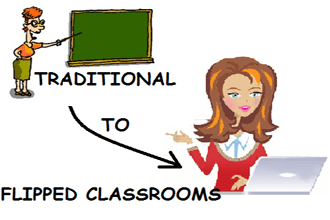In the recent past:
Teacher: Good Morning students.
Get ready with your notebooks, take your pencil, and look at the blackboard…
In the Near Future:
Teacher: Hello Students!
Adjust your screen, set your speaker acoustics.
In this video we shall be learning Theory of Relativity.
Now observe your PC screen…
Yes!!! You read it right.
What is the buzz about?
Flipping classrooms also called as reverse instruction or inverted classroom is the form of blended learning where with power of technology, teachers can now communicate with students, through online facilities and platforms where they can actually engage in teaching process through the lecture videos to students at ease.
There is a major transformation from CHALK and TALK ———-to———- CONNECT and CONVENE
Thanks to Wendy Roshan , we got to know about her experience in flipping her classroom.
Before the era of smart phones, computers and digital blackboards, education gizmos,
– Teachers stood at the front of a classroom and lectured
– Students wrote notes with pencils and pens.
– When the bell rang, teachers would verbally assign homework to students
– That evening, they would go home and work on the assignment.
In the early 1970s, this was the kind of environment that defined classrooms. But a lot has changed since then, both for students and educators.
Technology has been propelling every stream at high velocity. Education is not an exception. The practice of uploading lecture videos and making it available to the students at their disposal had been having a knock on effects on their scholastic platform. This idea has been in run and a good emerging tweak to attract mediocre students into learning and to boost up the rest. Few Indian institutions have taken up the sprouts of flipping classroom and many educators have this idea on the cards.
It may be through podcasts , YouTube videos or many learning websites, to deliver them to the fellow students.
Advantages:
Through flipping classroom technique the student can reap:
- 1:1 relationship, instead of the traditional, stale class room lecture methods.
- This can augment the advantages of incorporating Graphics, Holograms in case of Mathematics and animation videos for milking concepts of science like – Mechanism of Digestive Systems.
- Enable any place, any time, any number of time video watching facility.
- Storage and retrieval of videos is a cakewalk
- Greater visualization and better understanding.
Reeling back to a powerful antidote:
Change is the stable occurrence on the unstable livelihood. Though, some insist on educating students in the traditional way, new teachers from a different generation are embracing new technologies. One of these new teachers is Stacey Roshan , who is also a math teacher.
Stacey equipped teaching with new and innovative technologies and tools in the classroom. After learning about the screen-capture software, Camtasia Studio , Stacey began to record her lectures and assigned these videos for homework.
During class the next day, she would walk around the room and work with students individually. The flipped class model that Stacey was implementing created more 1-on-1 time for her to work with students and help them in unclear areas.
Her mother Wendy Roshan, who is also a teacher, after watching Stacey apply this model, decided to give the flipped model a try in her AP Calculus class. After using the model for one year, 80 percent of my students scored a “4” or a “5” on the AP exam.
Moving forward
Now she is planning to incorporate the flipped model into all of her classes. Stacey and her mother has spent this past summer recording lectures for Algebra II, which we are both teaching this year. Each video covers a lesson and is about twenty minutes long.
Camtasia has made the recording process surprisingly easy, as each video took us approximately one hour to tape and one hour to edit, a short amount of time considering all of the benefits that we and our students have already reaped.
Real Time Examples:
Classroom flipping technique has proved to be highly enticing arena for future educators. Many Foreign Universities has already taken up the reins of telecasting the lecture videos. Some examples are MIT, UCBerkeley, Stanford, Yale, Harvard, Carnegie Mellon, etc.
In India NPTEL is reaching wider horizons. Recent spot light was grabbed by BITS, Pilani where CISCO has deployed its virtual lecture facility that will benefit 11,000 students and 700 teachers with access to business leaders and guest lecturers around the globe.
A survey at Michigan’s Clintondale High School, USA has witnessed the effect of classroom flipping that wooed more students to involve in active learning process.
The Outcome is shown below:
English:
Before Flipping: Pass % – 48
After Flipping: Pass % – 81
Social Studies:
Before Flipping: Pass % – 72
After Flipping: Pass % – 91
Math:
Before Flipping: Pass % – 56
After Flipping: Pass % – 87
Science:
Before Flipping: Pass % – 59
After Flipping: Pass % – 81
Pure Statistics:
Only 69% of students who start high school, graduate at the end of the year, 31% don’t.
Each day 7,200 students DROP OUT of school, summing it up to whooping 1.3million per year.
Let’s analyze the effect of Classroom Flipping:
Before flip:
50% freshman failed in English
44% freshman failed in Mathematics
After flip:
19% of freshman failed in English
13% of freshman failed in Math
According to the institution, in an academic year of engaging flipping classrooms, the fail rate has abruptly shrunk from 30% to 10.8%.
Conclusion:
The Classroom Flipping is the highly luring to engage students in knowledge gaining than in absentminded class listening process. This can help even for longer retaining of concepts as it triggers better comprehending abilities. Even the middle class family now owns a computer with a broadband connection which is an axiomatic truth. Hence indulging technology into education takes the Teacher-Student culture at higher scales.
ENJOY FLIPPING CLASSROOM !


